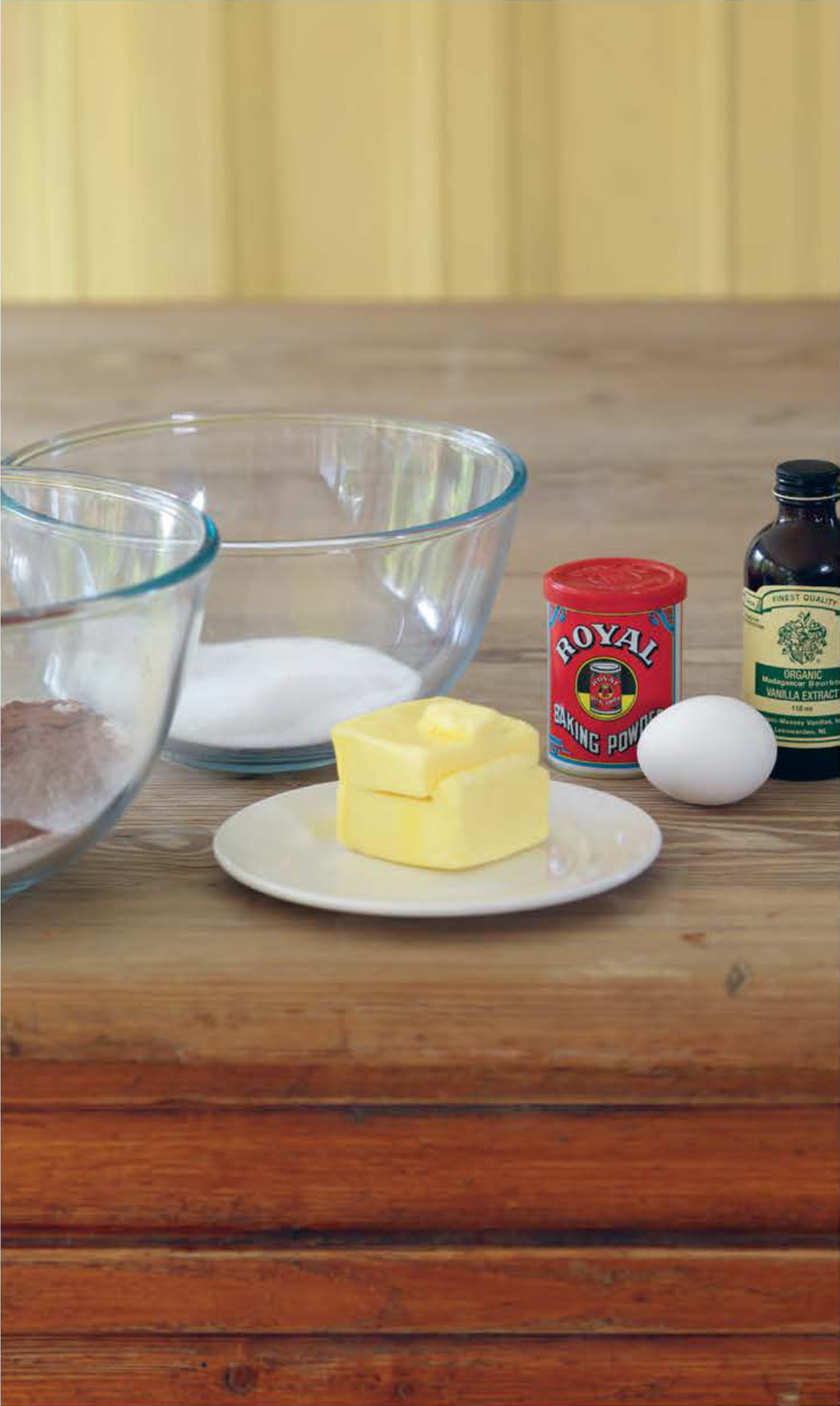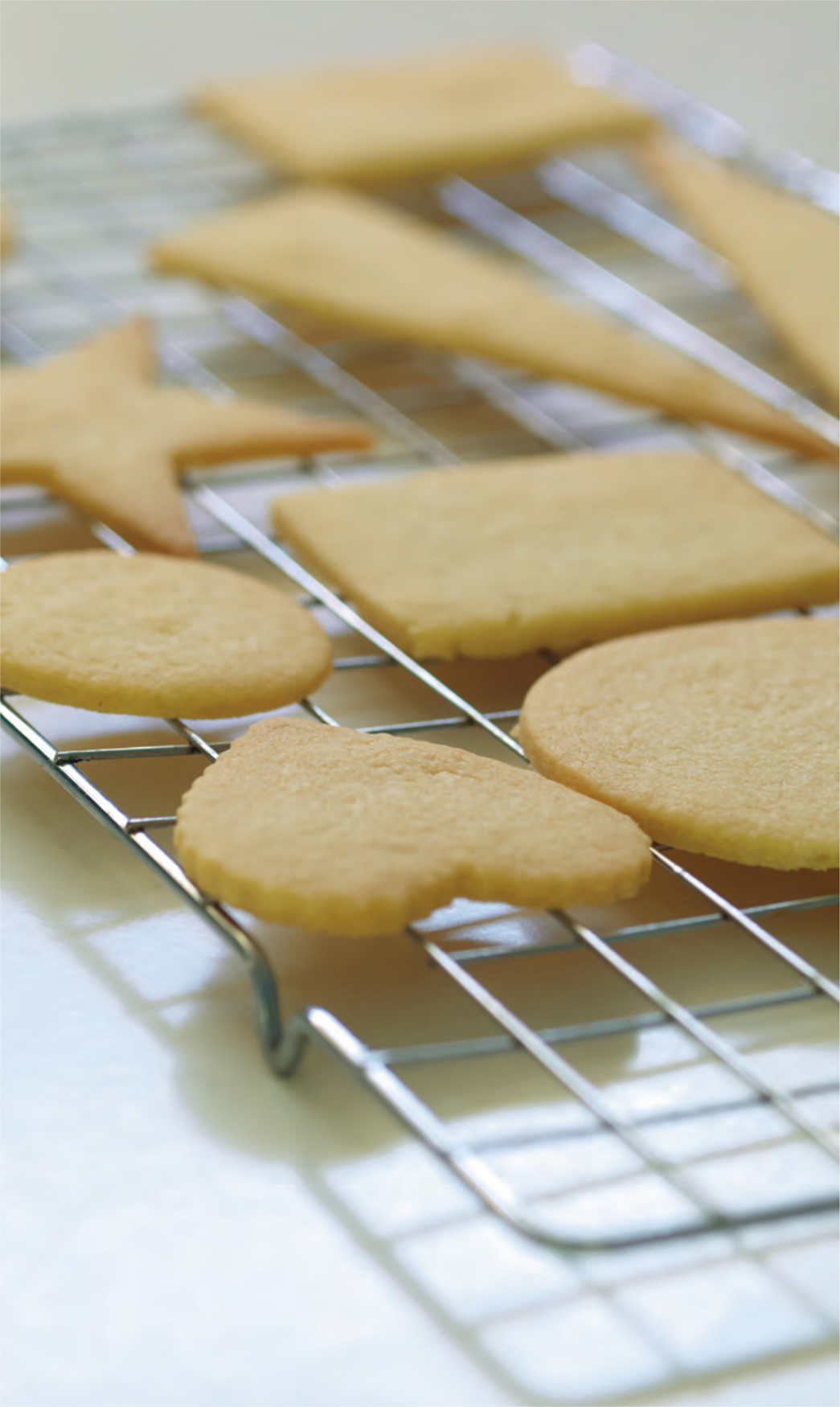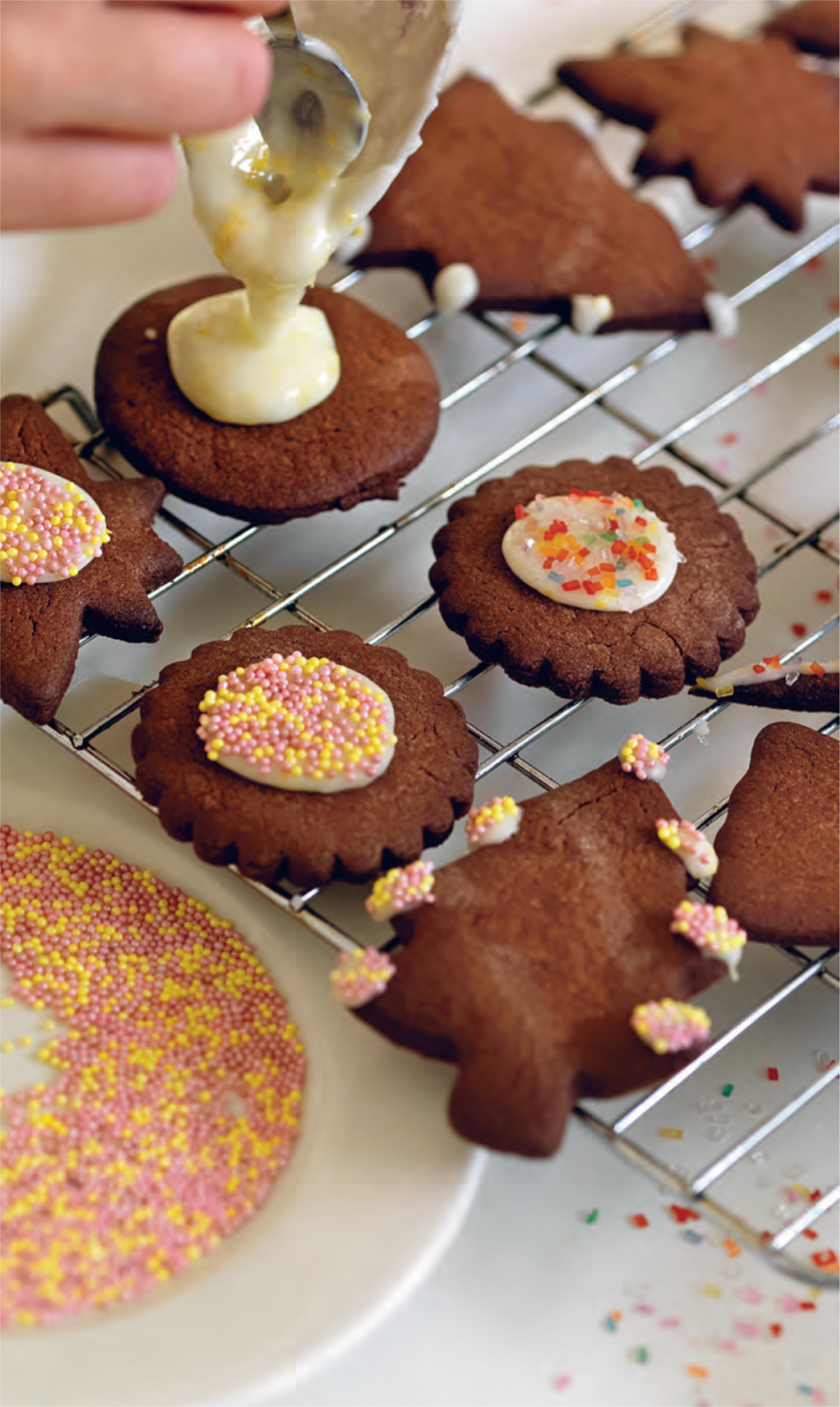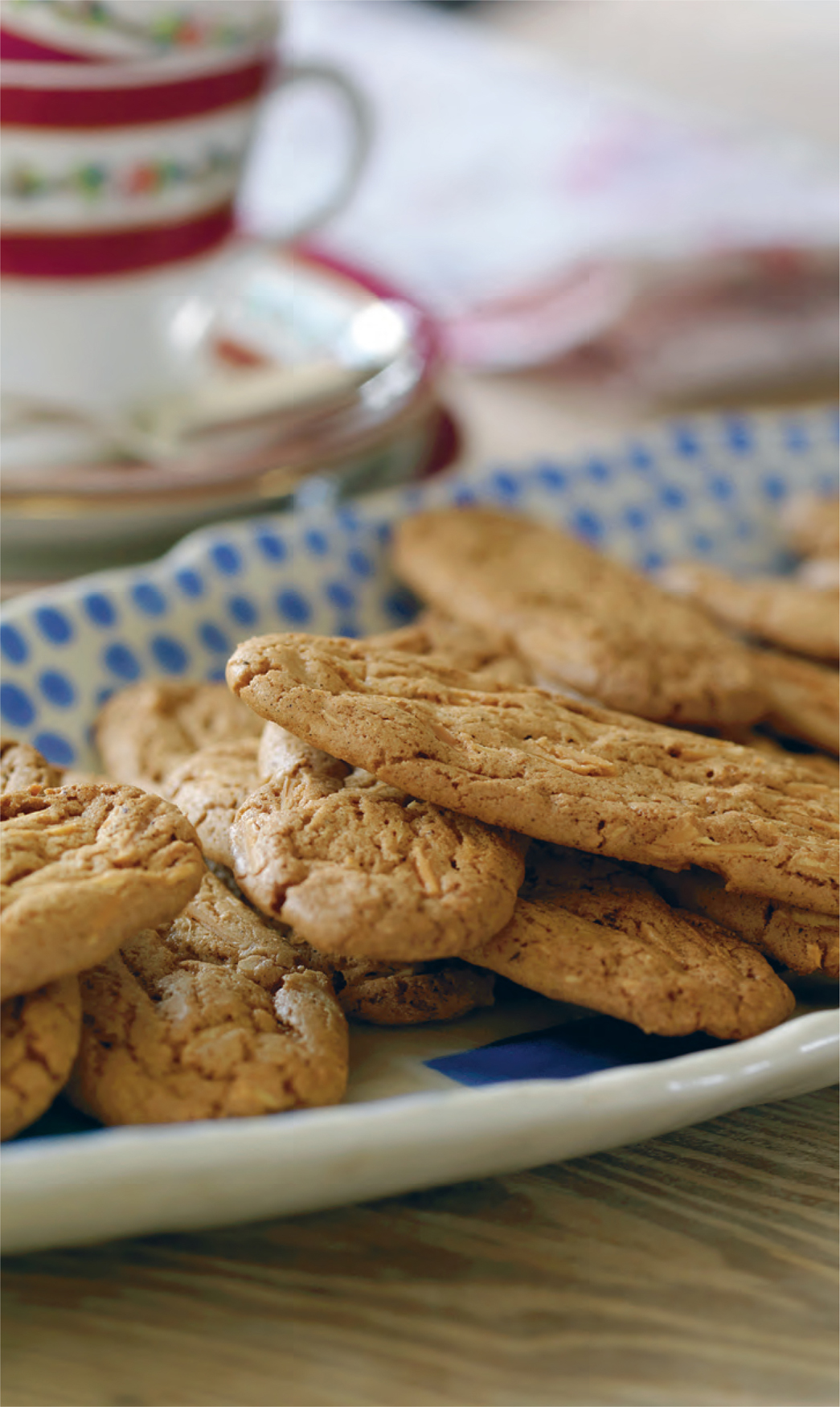
Chicken and other broths
Vegetable soups
Savoury tarts
Salads and dressings
Pan-grilling and pan-frying
Roasting
Casserole-roasting
Baked fish
Green vegetables
Roots and alliums
Potatoes
Rice
Pulses – beans, peas and lentils
Simple soda breads
Sweet essentials
Fruit fools, compotes and salads
Biscuits
Ice creams, sorbets and granitas
Meringues
Warm puddings
Cold puddings
A few cakes
‘I wonder how many people make biscuits any more. Have they been lost and forgotten under the tsunami of cupcakes? They are a lovely and genteel offering and can be exactly what is required at 11 a.m., or 3 p.m., or after dinner.’

A bowl of perfectly ripe autumn pears, a plate of biscuits, say Caramel and Almond Thins, and a glass of sweet wine… lovely.
Sometimes perfection is achievable, and with a carefully chosen and cooked biscuit, the scenario mentioned above is easily within your grasp. Biscuits are funny, though, and pretty as they may be, they rarely arrive at the table making a big song and dance. They are more a case of good tailoring rather than fancy accessorising, but they do arouse a funny set of emotions. There is none of the indulgent naughtiness associated with creamier or more lavish preparations. There will be no finger-pointing from fellow diners here when with a hovering digit you get to choose your own biscuit, which is exactly the shade that you like and not for sharing. It is quite acceptable to have a second one, and due to their generally slim and precise presentation, you might even sneak in a third. This multiple self-serving is a scenario that is unthinkable in the case of a cake or a tart. Biscuits just don’t carry that sort of baggage. They require none of the last-minute fru-fruing that some sweet things do and are unusual in that they can be exactly what is required at 11 a.m., or 3 p.m. or after dinner, and all of that without guilt. Generally, the most stressful decision you have to make when serving them is in respect of what serving plate will show them at their best. It is also worth mentioning that anyone who aspires to god-like status due to their superior domestic standards will, on nonchalant presentation of the freshly stocked biscuit tin to the unexpected visitor, be catapulted into a sphere previously unimagined by budding kitchen deities.
So do I like biscuits, do I think they are worthwhile, do I think that with the previously mentioned pears or other similarly ripe fruit, with a fruit compote or fool, with a simple ice, they can be as smart as anything you might offer? Yes, without doubt. Piled high, laid flat, spread out for dramatic effect or straight from the tin, a well-made homemade biscuit is a treat.
I wonder, though, how many people make biscuits any more. Have they been lost and forgotten under the tsunami of cupcakes that has swept all in its path? That previously lovely and genteel offering that only appeared at teatime seems to get bigger, more psychedelic, more vulgar and more forgettable by the day.
So let us keep our biscuits small, thin, crisp and buttery; with a multitude of flavourings, shapes and sizes, biscuits are a simple skill that is worth mastering. Most of the recipes are easy, and good quality ingredients as always will be reflected in the finished taste and texture. Some of the biscuit recipes here are best eaten on the day they are made; others will keep in a tightly sealed tin for several days. Some of the biscuit doughs are frozen in an uncooked state and can then be sliced directly from frozen on to a baking tray lined with baking parchment, with no rolling required, and cooked as you need them, so they’re really quick and perfect for those who like to plan ahead and are also a safety valve in the event of unexpected visitors. The remaining frozen dough goes straight back into the freezer for use another day.
Keys to success
The pastry kitchen is unforgiving – if you don’t weigh your ingredients accurately, you cannot be guaranteed a good result.
When butter is called for in a recipe, there is no substitute that will yield as delicious a result. The butter can be salted or unsalted. I generally state my preference in each recipe.
Where the use of baking parchment is suggested, it is there for a good reason, generally to ensure that your biscuits will definitely not stick to the tray they are being cooked on.
Though some of the biscuits keep well in a sealed tin or box, there is no doubt that they all taste better when freshly baked.

Vanilla shortbread biscuits
I have many different biscuit recipes that I like, but I think this one is immensely useful and it has many possible variations. This is a classic example of a few simple ingredients, accurately measured and carefully cooked, producing a consistently good result. The value of such a recipe cannot be overstated, as you can rely on its good humour and reliability. The biscuit is crisp, sweet and buttery and the addition of some vanilla seed, scraped from a vanilla pod, adds a lovely flavour.
In their simplest form, cooked as flat biscuits, these can be served with tea or coffee. They can be sandwiched together with soft fruit such as strawberries and raspberries to make an elegant little afternoon tea treat or dessert. Gently pressed into tartlet tins and cooked, they make delicious receptacles for jams, jellies and preserves. I sometimes put a teaspoon of jam and a few berries on to the raw rolled tartlets and bake them to make very delicate jam and fruit tarts. Like most buttery pastries, these are without doubt best eaten on the day they are made, though they do keep well in a biscuit tin for a couple of days.
You will know that I am a big fan of an accurate weighing scale, measuring jug and spoons. I like to give myself every chance of success, and when I know that I have the correct amount of ingredients in my bowl, that is already a good start. Biscuits and pastries are much less forgiving than, say, a slow-cooked stew, so cooking times are also crucial. Here the rules and guidelines really matter, and because I think this is such a marvellous recipe, I would really like it to work properly for you so that it may become a regular and most useful part of your repertoire. So quite plain, and without bells and whistles, this biscuit punches above its weight in terms of texture and flavour. It is a classic example of the value of using butter and where possible the value of eating a buttery biscuit or pastry on the day it is made. If you make this biscuit with salted butter it will taste like an Irish or English delight; if you use unsalted butter, immediately it tastes more of France or Italy. There may be better biscuit recipes than this but there are few that are so straightforward, and that reward so generously for such a small amount of effort.
The ingredients
A vanilla pod or bean with its pungent and aromatic aroma is an essential ingredient in the sweet kitchen and indeed sometimes finds its way into the savoury kitchen as well. If possible buy pods that are flecked with a white crystal coating which contains vanillin; known as frosted vanilla, these are generally the most highly flavoured beans. Avoid pods that feel dry to the touch to the point of being brittle. Store the pods in an airtight container or in a jar of caster sugar to make your own homemade vanilla-flavoured sugar.
Makes 20 170g plain white flour
3cm piece of vanilla pod
110g butter, diced
55g caster sugar
Preheat the oven to 180°C/350°F/gas 4.
Put the flour into a bowl. Split open the vanilla pod with a knife and then, with the back of the knife, scrape the tiny little seeds into the flour. Mix thoroughly to disperse the dry vanilla through the flour. Add the butter and sugar and rub them into the flour until the mixture resembles coarse breadcrumbs. Keep rubbing and it will come together into a mass. Knead lightly to form a smooth dough. Do not be tempted to add any liquid. If you have measured the ingredients accurately it will work. If it feels a little soft, chill for 15 minutes.
Roll out on a floured surface to a thickness of 3mm. Cut out the shapes of choice with pastry cutters (you will get about 20 biscuits if you use an 8cm cutter) and transfer to a baking tray. Gather up the trimmings, lightly shake off the excess flour and roll and shape again. Bake in the preheated oven until golden. Immediately remove from the baking sheet and place on a wire rack to cool. If you leave them on the oven tray they will stick and burn.
The biscuits can be simply served with a light dusting of caster or icing sugar. Best eaten on the day they’re made, but they will keep for 2–3 days in an airtight box or biscuit tin.
Sugar biscuits
Crisp, golden, caramelised, thin and elegant, these long slipper-shaped biscuits can be served with ices, sorbets, mousses and soufflés, or just with coffee. Scraps of puff or flaky pastry will work perfectly here. The pastry is rolled in icing sugar and cooks to a crisp caramel. I like to make my own puff pastry. If you are going to use shop-bought pastry, use the very best all-butter variety that you can find.
The ingredients
The puff or flaky pastry you use must be made with butter, as anything less will produce an ordinary biscuit. That would be a pity, as these biscuits can be fantastic. Use the pastry chilled from the fridge and don’t allow it to warm up, otherwise it will become difficult to handle.
Makes 14 100g icing sugar, sieved
200g puff pastry
Preheat the oven to 220°C/450°F/gas 7.
Dust your work surface and the pastry with some of the icing sugar. Roll the pastry into a 25cm square and dust with more icing sugar. Fold the left-hand and right-hand side of the square of pastry halfway towards the middle. Fold again so that the two sides meet in the middle of the pastry. Now fold one side on top of the other and firm it gently in place with the heel of your hand. Cut the pastry into 2.5cm pieces. Turn these pieces on their side with the cut side up. Dust again with icing sugar, flatten with the heel of your hand and roll into long tongue-shaped biscuits as thin as a sheet of pasta. They should be about 15–20cm long and 4–5cm wide. If the pastry starts to come apart at the folds when you are rolling it, just pinch it together and keep going. Use more icing sugar if the pastry is sticking to the work surface or the rolling pin.
Place on a baking sheet, then bake until golden brown. They may need to be flipped over during the cooking. Be brave and allow them to become well caramelised. Remove from the oven, then with a slice or palette knife place them on a wire rack to cool. They will become crisp and brittle.
Best eaten on the day they’re made, but they will keep for a day or two in an airtight box or biscuit tin.
Sacristains: almond and sugar pastry twists
I hope most people have had one of those moments when you taste something so delicious that it suddenly explains why a particular cuisine or dish has achieved an exalted and revered position. I think these biscuits can produce such an effect.
If you want to produce a pastry or biscuit that makes your eyes roll with pleasure, there are two words you will need to remember – butter and freshness. The pastry being used, puff pastry in this case, needs to be made with butter and it needs to be really fresh. The pastry and biscuits should be made, cooked and eaten on the same day. Anything less than butter and freshness will only produce a mediocre result.
These biscuits are one of the reasons why we used to, and sometimes still think, that French pâtisseries are a little outpost of heaven on earth. Sugar-coated, almond-studded and slightly caramelised twists of crisp, fluffy and buttery pastry. Divine.
The ingredients
Butter puff or flaky pastry, as fresh as possible, is needed here.
The almonds, with their skins left on, will retain much more flavour than previously skinned ones.
Makes 15 Flour, for dusting
200g puff or flaky pastry
1 egg, beaten
115g unskinned whole almonds, coarsely chopped
75g granulated sugar
Preheat the oven to 200°C/400°F/gas 6.
Lightly dust the work surface and the pastry with flour. Roll the pastry into a rectangle, 30cm wide and 20cm long. Brush off any excess flour. Brush the pastry with beaten egg. Sprinkle on half the almonds and half the sugar and press them into the pastry by giving it one firm roll with your rolling pin. Carefully flip the pastry over, again brushing off excess flour, and repeat with the egg, almonds and sugar. Again press in the nuts and sugar with the rolling pin. Cut the dough into 15 strips about 2cm wide and 20cm long.
Line an oven tray with baking parchment. Catch the pastry strips at each end one at a time, and twist them several times to give the pastry four or five obvious twists. Lay them as you go on the paper, leaving 3cm of space between them. Bake in the oven for 15 minutes, until risen and richly caramelised. Remove from the tray and allow to cool and crisp on a wire rack.
Best eaten on the day they’re made, but they will keep for a day or two in an airtight box or biscuit tin.

Chocolate biscuits
These biscuits are particularly festive-looking at Christmas when you can shower them with all manner of shiny edible decorations – hundreds and thousands, coloured sugars and so on. They cut beautifully into different shapes, so this may be the moment to use your fanciest biscuit cutters. Like the Currant and Candied Fruit Biscuits, though, they can be enjoyed at any time of the year. During the summer months these biscuits are delicious sandwiched together with lightly sweetened berries such as raspberries, loganberries or tayberries, and vanilla ice cream or whipped cream.
The ingredients
Cocoa powder, another important ingredient in the sweet kitchen, should be dark and completely unsweetened.
The pure vanilla extract used here should not be confused with vanilla essence. The extract is pure, dark, perfumed and low in sugar, indeed sometimes with no sugar at all. Generally, the pure extracts contain at least 35% alcohol. The essences tend to be low in vanilla and alcohol and high in sugar, a pale imitation of the real thing. It is quite easy to make your own extract by macerating slashed vanilla beans in water and brandy, bearing in mind the 35% of alcohol as a general rule.
Makes 36 140g salted butter, at room temperature, but not hot and oily
1 tablespoon vegetable oil
125g caster sugar
1 egg, beaten
1 teaspoon vanilla extract
225g plain flour
35g cocoa powder
1 teaspoon baking powder
Place the butter, oil and caster sugar in a bowl. By hand with a wooden spoon, or with the aid of a machine, cream together until light and fluffy in consistency and pale in colour. Add the egg and vanilla and continue to beat until well blended and smooth. Sieve the flour, cocoa and baking powder on to the mixture and blend in until it comes together and no longer looks streaky. Do not over-mix. Chill the mixture for at least 30 minutes.
Preheat the oven to 180°C/350°F/gas 4.
Roll out half the mixture at a time to about 5mm thick, using a little flour to prevent it from sticking. Alternatively, roll it between sheets of baking parchment. Cut out the biscuits with your cutter of choice (you should get about 36 if you use a 5cm cutter), then, using a palette knife, place on a baking sheet lined with baking parchment. Leave a little space between the biscuits, as they swell slightly when cooking. Bake in the preheated oven for about 8 minutes. The biscuits will rise slightly and feel gently set to the touch. They crisp up as they cool. Place the baking sheet on a wire rack and allow them to cool, still on the baking parchment.
Serve dusted with a little icing sugar or caster sugar, or ice with one of the icings suggested below. If you are using the icing and wish to sprinkle the biscuits with edible decorations, make sure to do that as soon as the biscuits are iced so that the decorations will stick on to the still slightly moist icing.
Best eaten on the day they’re made, but they will keep for 2–3 days in an airtight box or biscuit tin.
Lemon glacé icing
For 30 biscuits 110g icing sugar
Zest of 1 lemon
About 1 tablespoon lemon juice
Sieve the icing sugar into a bowl. With a wooden spoon, carefully mix in the lemon zest and enough juice to make a spreadable icing. Beat until smooth and glossy. The consistency will be that of thick cream.
Coffee glacé icing
For 30 biscuits 110g icing sugar
1 dessertspoon coffee essence, such as Irel or Camp
1 tablespoon boiling water (approx.)
Sieve the icing sugar into a bowl and add the coffee essence. With a wooden spoon, add enough boiling water to achieve a smooth and glossy icing. The consistency will be that of thick cream.
Dark chocolate icing
For 30 biscuits 75g icing sugar
25g cocoa powder
40g butter
40ml water
50g caster sugar
Sieve the icing sugar and cocoa powder into a bowl. Put the butter, water and caster sugar into a small saucepan and stir on a low heat until the sugar has dissolved. Bring to the boil and immediately beat into the dry ingredients. Continue to beat with a wooden spoon until smooth and glossy. The icing will thicken as it cools.

Caramel and almond thins
These thin, crisp and delicious biscuits have many different uses. The original recipe comes from Chez Panisse, in Berkeley, California, where for forty years the inspirational Alice Waters and her team have been celebrating all that is good and local in food. I was lucky enough to spend a month in the kitchens of Chez Panisse a few years ago. I tasted these biscuits there and have adjusted the recipe slightly to suit our measurements and ingredients. They can be served with tea and coffee. They are good with ice cream and sorbets. They are fine enough to be served as a petit four. I also serve them with a blackberry and apple fool in the autumn and mango fool in winter. They are very handy, as the slab of uncooked biscuit keeps in the freezer and you can slice off thin sheets and cook them as needed.
The ingredients
If possible, grind the cinnamon freshly for this recipe. This is easily done in a spice grinder or clean coffee grinder. Otherwise, use the freshest ground cinnamon that you can find.
Flaked almonds with their skins still attached have a more interesting flavour than skinned ones, but if that is all you can find, these biscuits will still be delicious.
Makes 60 250g plain flour
¼ teaspoon bicarbonate of soda
100g salted butter
½ teaspoon ground cinnamon
5 tablespoons water
300g soft light brown sugar
110g flaked almonds, unskinned if possible
Sieve the flour and bicarbonate of soda into a bowl. Put the butter, cinnamon and water into a saucepan on a low heat until just melted. Do not allow to boil. Remove from the heat and add the sugar. Stir into the flour mixture with the almonds.
Place the dough on a piece of strong plastic (not cling film) or baking parchment and form it into a neat rectangular slab, about 23cm wide, 2.5cm thick, and 9cm long. I use the sides of a shallow baking tray to help me to achieve neat and straight edges. Put into the freezer until firm.
Preheat the oven to 180°C/350°F/gas 4. Slice the dough into 3mm thick slices and place them on a baking sheet lined with baking parchment, allowing a little room between the raw biscuits for expansion during cooking. Bake for 10 minutes, until golden brown. Slide the biscuits, still on the paper, on to a wire rack to cool.
Best eaten on the day they’re made, but they will keep for 2–3 days in an airtight box or biscuit tin.
Currant and candied fruit biscuits
This is another Chez Panisse-inspired biscuit. I particularly like them at Christmas time, when I make them and give them as gifts, but in fact they are great at any time of the year. Apart from serving them with tea or coffee, I sometimes accompany them with Praline Ice Cream.
This biscuit dough is prepared ahead, formed into a roll, wrapped in cling film and frozen. When you need a few biscuits, simply slice them off the roll and bake. The cooked biscuits keep well for several days in an airtight container.
The ingredients
Currants are tiny raisins made from drying a variety of small black grape. Like raisins and sultanas, they vary enormously in quality, so seek out ones that, when you taste them, remind you that this little dried fruit was once actually a grape. Store them in a sealed container.
Candied peel can be made from many different members of the citrus family, such as oranges, lemons, limes, grapefruits, tangerines, pomelos and so on. Like the dried fruit mentioned above, it varies in quality, and perhaps the safest way, apart of course from making your own (see here), is to buy it in large pieces so that the fruit it was made from is still somewhat recognisable. The pre-chopped versions tend to taste of nothing but sugar. The difference between good candied peel and the run-of-the-mill commercial brands is enormous.
Makes 70 275g salted butter, at room temperature but not warm and oily
225g caster sugar
1 egg, beaten
1 teaspoon vanilla extract
275g plain flour
75g currants
75g candied orange and lemon peel, finely chopped
By hand or in a food mixer, cream the butter and sugar until light and fluffy. Add the egg and vanilla and mix in thoroughly. Stir in the flour, currants and candied peel and mix gently but thoroughly to just combine the ingredients.
Form the dough into two logs, about 4cm in diameter. Place each log on a sheet of heavy plastic (I use a heavy duty plastic freezer bag which I cut open to make bigger), and form into a neat roll while squeezing the plastic to attain a neat finish. Twist the ends of the plastic to seal the roll and place in the freezer until frozen.
When ready to cook the biscuits, preheat the oven to 180°C/350°F/gas 4 and line a baking sheet with baking parchment.
Slice the dough into 3mm rounds and place on the paper, leaving 1cm of space between the biscuits. Bake for about 12 minutes, until the biscuits are golden. Cool on the baking parchment and enjoy.
Best eaten on the day they’re made, but they will keep for 2–3 days in an airtight box or biscuit tin.